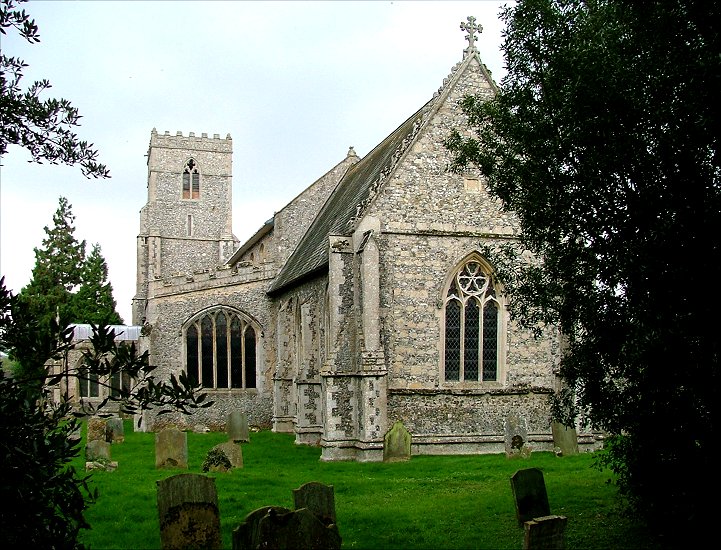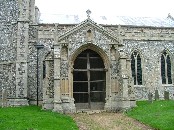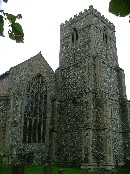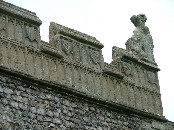
home I index I latest I glossary I introductions I e-mail I about this site
St Lawrence, Harpley

Read
the captions by hovering over the images, and click on them to
see them enlarged.




| St
Lawrence, Harpley Harpley is one of the tiny villages just off of the Lynn to Fakenham road. There are not many people around here; it is is an area of lost churches, and there are perhaps thirty ruins within ten miles. But perhaps it is a wonder that so many others have survived. St Lawrence is a big, rambling church, large enough to reveal itself in two distinct periods. Firstly, the mystery and excitement of its early 14th century Decorated tower and chancel, from the days before the Black Death; and then, the seriousness of the Perpendicular clerestory, aisles and porch from a century later. The great west window in particular resonates with the openness of this late-medieval Catholic rationalism. The 15th century left a rare treasure. This is the south door, still in its original setting. It has a wicket opening, and the whole piece is replete with carved imagery. There are eight figures, four up either side, wearing medieval dress. The four lower figures are the four Latin Doctors of the Catholic Church: St Augustine, St Jerome (recognisable by his Cardinal's hat) St Gregory and St Ambrose. The four upper figures are the Four Evangelists: St Matthew, St Mark, St Luke and St John. They hold scrolls, and have their symbols with them. The wicket gate has an angel holding a shield (the 'R' on it is a later grafitto) flanked by two winged creatures - they may be the bull and eagle of St Luke and St John, but I suspect that they are actually a decorative gryphon and eagle. St Lawrence is one of those churches that is memorable for its atmosphere; the gloomy light, the old woodwork, the creamy stone, the slightly shabby yet familiar interior of a Decorated space. High above, the angel roof is unlike any other, with small carvings punctuating silvery beams, darkening as evening falls. Unfortunately, the otherwise fine roodscreen was completely repainted in the 1860s in a flat, gaudy style. It is interesting for having Old Testament prophets on the sides and the extended Holy Family with St Lawrence on the doors, but there is no reason to think that the subjects reflect faithfully what was there before. However, this is in part compensated for by the survival of a lovely early 14th century double piscina in the nave, and another in the chancel which must have been splendid before the coving was smashed. There is a finely detailed Easter sepulchre with an elaborate coving to the priest door beside it. Best of all in the chancel is the impressive burial slab, its brass now gone but the inlay still striking. It remembers John de Gurney, Priest here in the first third of the 14th century, who built all this. A shilling life will give you all the facts, wrote Auden, and on this site I am too often guilty of the sin of Pevsner, detailing a catalogue of architectural features, furnishings and medieval survivals without ever going any deeper into what it all actually means. But all the time I am conscious that, as I wander in these spaces, a parish church is much more than the sum of its parts, and to enter one is to be in a place that is not merely spiritual, but a touchstone to the long generations that have known it as the heart of their lives. Perhaps that is the same thing. I have explored a thousand East Anglian churches in the last five years. This was the thousandth. Each one has been similar in form, and yet again so different, the cadences and emphases inventing an entirely new story each time, as if I was seeing a church as I have never seen it before, and understanding it at last. Perhaps it's like Eliot said: the end of all our exploring will be to arrive where we started, and know the place for the first time. For hundreds of years, for people who are so remote from us but who would, I think, be recognisable, these places were the focus for their passions and their griefs, their hopes and fears, their rites of passage and their sense of continuity. Through the Catholic sacraments and their own private devotions they recognised and found their place in a world that was so much greater than the physical mundanity around them; the preaching of their protestant preachers educated them, built them up, and carried them forward. This continues today. All the time, the great medieval pile was at the centre of our shared sense of community, counting the hours, marking our coming in and our going out, celebrating the great trinity of birth and sex and death. The building remains; the people grow old and die, leaving only a memory of themselves. These are the ghosts that haunt our parish churches; the absences, the resonances that shimmer through the shadowed, empty spaces. To enter a church like St Lawrence, Harpley, is to reach out and touch not only the eternal, but that which is internal; the echo of all that is absent. A medieval church does this in extremis, but any object can do it. I admire the way that the artist Rachel Whiteread tries to make these empty spaces overt by filling them in and then removing the moulds - most famously in House, where she poured concrete into an empty house which was then demolished around the solidified mass, and also in Nine Tables at Tate Modern which attempts to do the same. Her Embankment, filling the Turbine Hall as I speak, is a haunting meditation on the theme of loss and memory; thousands of casts of the insides of suitcases and trunks, reproduced in white plastic and piled up like icebergs, sugarloafs and snowdrifts. Constrained by words and pictures, I stretch vainly to reach a similar way of showing and telling; I can give you all the facts, but a parish church is so much more than this. History has come down on it like softly falling snow, settling into strata, the transparent and opaque layers forming unique masses occasionally disturbed by the tremors of traumatic events; the Reformation, pestilence, wars. Every church is new to me. Ultimately, all I can say, all I can encourage, is Come and See. Simon Knott, November 2005 |
Amazon commission helps cover the running costs of this site.
home I index I latest I introductions I e-mail I about this site I glossary
links I small
print I www.simonknott.co.uk I www.suffolkchurches.co.uk
ruined churches I desktop backgrounds I round tower churches